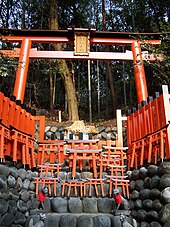f4f
翠鸟科
Tricksters


The Fushimi Inari shrine in Kyoto features numerous kitsune statues.
Kitsune are often presented as tricksters, with motives that vary from mischief to malevolence. Stories tell of kitsune playing tricks on overly proud samurai, greedy merchants, and boastful commoners, while the crueler ones abuse poor tradesmen and farmers or devout Buddhist monks. Their victims are usually men; women are possessed instead.[16] For example, kitsune are thought to employ their kitsune-bi or fox-fire to lead travelers astray in the manner of a will o' the wisp.[46][47] Another tactic is for the kitsune to confuse its target with illusions or visions.[16] Other common goals of trickster kitsune include seduction, theft of food, humiliation of the prideful, or vengeance for a perceived slight.
A traditional game called kitsune-ken (fox-fist) references the kitsune's powers over human beings. The game is similar to rock, paper, scissors, but the three hand positions signify a fox, a hunter, and a village headman. The headman beats the hunter, whom he outranks; the hunter beats the fox, whom he shoots; the fox beats the headman, whom he bewitches.[48][49]


The Fushimi Inari shrine in Kyoto features numerous kitsune statues.
Kitsune are often presented as tricksters, with motives that vary from mischief to malevolence. Stories tell of kitsune playing tricks on overly proud samurai, greedy merchants, and boastful commoners, while the crueler ones abuse poor tradesmen and farmers or devout Buddhist monks. Their victims are usually men; women are possessed instead.[16] For example, kitsune are thought to employ their kitsune-bi or fox-fire to lead travelers astray in the manner of a will o' the wisp.[46][47] Another tactic is for the kitsune to confuse its target with illusions or visions.[16] Other common goals of trickster kitsune include seduction, theft of food, humiliation of the prideful, or vengeance for a perceived slight.
A traditional game called kitsune-ken (fox-fist) references the kitsune's powers over human beings. The game is similar to rock, paper, scissors, but the three hand positions signify a fox, a hunter, and a village headman. The headman beats the hunter, whom he outranks; the hunter beats the fox, whom he shoots; the fox beats the headman, whom he bewitches.[48][49]


